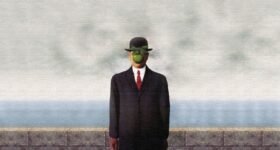
Is this a Religious Portrait or An Image of Conformist Commercial Exploitation?
Is this a Religious Portrait or An Image of Conformist Commercial Exploitation?
The “Son of man” is one of surrealism’s most well-known artworks that now propagates through pop culture through its revival in countless comic strips, plays and cartoonish imageries. At the surface level of analysis, the artwork captures a man dressed in an articulate formal attire (Overcoat, red tie and hat) standing in front of grey-bricked wall amidst the view of an endless blue sea that is merged with a dusk-lit cloudy sky. Most notably, his facial features are camouflaged and obscured by a floating green apple whose leaves are unplucked and consequently becomes the explicit indicator of the painting’s surreal character.
An Algorithm for Artistic Analysis
To analyse artworks, I use the approach of establishing an artwork’s contextual foundation through acts such as skimming through the artists personal history and linking it with the motifs and design elements used in his paintings. This step also involves viewing the painting through the lens of time: it entails re-examining the historical events, societal structures, and artistic themes that were prevalent during the period when the painting was completed or the era it depicted. These elements serve as crucial sources that help establish the contextual backdrop of the artwork.
Contextual insights are then fed through a phase in which artworks are scrutinised in search for obscured symbols and stories that are inherent through artistic techniques be it colour, objects, lines, forms or any other artistic elements. Summing individual stories can rebuild a new narrative, culminating in interpretation that re-epitomises the meaning behind the artwork. Through, this analysis I’ve narrowed the results of this algorithm into two broad thematic interpretations on what I believe this artwork portrays and manifests.
1. Divinity, Curiosity & Jesus’s Portrait
In René Magritte’s “The Son of Man,” the apple is often seen as a meaningless distracter, drawing the viewer’s eyes away from the man’s covered face. This obscured visage naturally sparks a sense of curiosity and alacrity in the viewer, compelling them to seek the hidden details of the face. This element suggests the inherently curious nature of humanity, always desiring to uncover the ideas and truths concealed behind visible surfaces. Magritte posits that everything we see hides another thing, paralleling the notion that the for instance, the smiling face of a depressed person can conceal his/her deep sorrow or how a sunflower’s pistil is a numerical pattern of a recursive summation of consecutive numbers. The covered face in the painting underscores the totality of thus theme, highlighting humanity’s natural inclination to seek truth hidden behind everyday things which remains integral in all human endeavours be it scientific exploration, philosophical reasoning or artistry itself. Through this lens, Magritte deftly incorporates and integrates the viewer into his artwork, thereby reinforcing his message on human curiosity and its innate inquisitiveness.
The apple in the painting can also be interpreted through its biblical symbolism. In the story of Adam and Eve, the apple signifies knowledge and power. The title of the painting, “The Son of Man,” ironically refers to a title used for Jesus, which appears 64 times in the Bible and signifies both Jesus and a universal term for humanity. Combining these divine elements, we can see the apple once again as symbolising mankind’s quest for knowledge, striving to uncover meanings concealed beneath the surface.
Further exploring the divine aspect, “The Son of Man” can be seen as a portrait of Jesus. The title itself is a biblical term frequently associated with Jesus Christ. This connection invites an interpretation that aligns the painting with themes of spirituality and redemption. The apple, reminiscent of the forbidden fruit from the Garden of Eden, symbolises humanity’s fall and the subsequent need for redemption—a role Jesus is believed to fulfill in Christian theology.
The unplucked leaves on the apple enhance this interpretation. They suggest purity and untouched nature, possibly symbolizing Jesus’ untainted and divine essence. The leaves also emphasise the natural state of the apple, linking it to the story of original sin and the quest for knowledge. Magritte’s surreal style often challenges the viewer’s perception by placing ordinary objects in extraordinary contexts. The apple obscuring the man’s face serves as a metaphor for the hidden aspects of reality. It compels the viewer to look beyond the surface and question the deeper meanings concealed within.
This interplay of the hidden and the revealed is central to human experience. Just as the apple hides the man’s face, everyday objects and actions often conceal deeper truths. This theme resonates with the idea of spiritual and philosophical exploration, where uncovering hidden truths is a path to greater understanding.
The apple’s symbolism as the forbidden fruit ties into the human pursuit of knowledge. In the biblical narrative, the apple represents the knowledge of good and evil, and humanity’s insatiable curiosity to understand the world. This quest for knowledge is a fundamental aspect of human nature, driving scientific discovery, religious enlightenment, and intellectual growth. The painting, with its surreal elements and symbolic depth, invites viewers to contemplate the nature of existence and the layers of meaning hidden within the visible world. It challenges us to consider how much of reality is masked and how our quest for knowledge is a journey to uncover these hidden truths.
2.Conformity, Commercial Exploitation and Frustration
René Magritte’s “The Son of Man” can be interpreted through multiple lenses, and one particularly compelling perspective is viewing the surreal masterpiece through the eyes of Magritte’s critique of the commercial world. This interpretation examines the tapestry of businesses, trade, and deals explicitly communicated through the man’s formal attire, reflecting the intricate dynamics of corporate life.
The apple obscuring the man’s face becomes a potent symbol of compliance and conformity. Magritte was known to be critical of societal norms and expectations, and this painting can be seen as a direct commentary on the corporate world’s demand for conformity. In this context, the apple is a tool that obscures not only the man’s vision of the world but also the world’s view of the man. This deliberate concealment represents how corporate systems often force individuals to hide their true selves, including personal preferences, facial defects, or controversial ideas, in order to fit into established norms and standards. This phenomenon, known as conformity, is a psychological process where individuals alter their beliefs and behaviours to align with those of the majority. In the corporate world, this pressure to conform can stifle creativity, individuality, and authenticity. Employees often feel compelled to present a façade that aligns with corporate expectations, which can lead to a suppression of true identity and personal values.
Despite conformity being largely viewed as a negative force that inhibits our ability to showcase our true selves, it also allows the world to be less complex and more standardized, fostering unified ideas and opinions. However, the dark, gloomy, and dull colours reflected in the background of this artwork suggest that Magritte viewed conformity in a negative light, portraying it as a phenomenon that leads to inner guilt, distrust, dishonesty, and forgery. The faceless businessman epitomizes the loss of personal identity and the emotional toll of adhering to corporate norms.
This painting also reflects the frustration and commercial exploitation inherent in the corporate world. The man’s formal attire represents the articulate, meticulously crafted image that individuals in the corporate sphere are often forced to maintain. This image is a mask that conceals their true selves, driven by the need to fit in and succeed within a system that prioritizes uniformity and compliance over individuality and authenticity. The apple, then, can be seen as a symbol of the distractions and superficial goals imposed by the corporate world, diverting attention from genuine self-expression and personal fulfillment.
Magritte’s work invites viewers to reflect on the psychological and emotional consequences of conformity in the business environment. The pressure to conform can lead to a loss of personal integrity and a sense of alienation, as individuals feel disconnected from their true selves. This alienation is further emphasized by the surreal nature of the painting, which blurs the line between reality and illusion, underscoring the disorienting effects of a life lived in constant conformity.











Leave a Comment